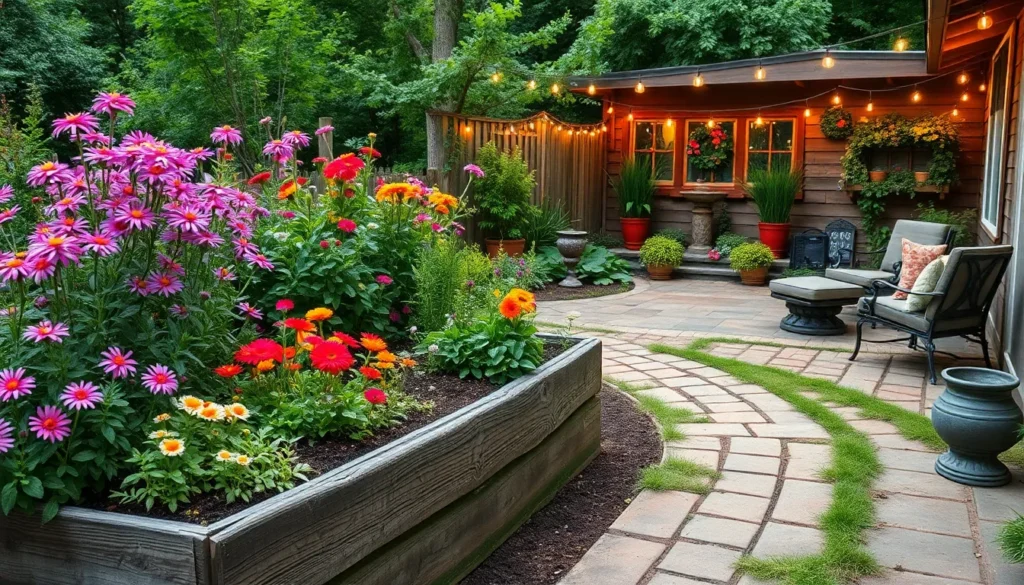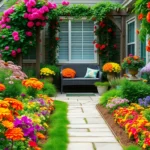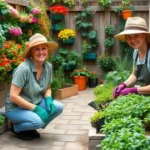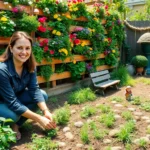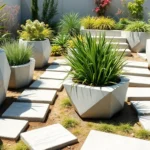We’ve all dreamed of transforming our outdoor spaces into stunning gardens that reflect our personality and enhance our home’s curb appeal. Whether you’re working with a sprawling backyard or a compact patio, the right garden ideas can turn any outdoor area into your personal oasis.
Creating the perfect outdoor garden doesn’t require a massive budget or professional expertise – it just needs thoughtful planning and creative vision. From vibrant flower beds and herb gardens to innovative container displays and sustainable landscaping answers, there are countless ways to bring your outdoor space to life.
We’ll explore practical and inspiring garden ideas that work for every skill level, budget, and space constraint. These proven strategies will help you design an outdoor sanctuary that not only looks incredible but also provides years of enjoyment for you and your family.
Create a Stunning Flower Garden for Year-Round Color
Designing a flower garden that maintains vibrant color throughout all seasons transforms any outdoor space into a captivating display. Strategic plant selection and thoughtful arrangement ensure continuous blooms from early spring through late fall.
Choose Native Perennials for Low Maintenance
Native perennials form the backbone of sustainable flower gardens that thrive with minimal intervention. We recommend selecting plants adapted to your local climate zone for optimal growth and reduced water requirements.
Research your region’s indigenous species through local extension offices or native plant societies. Popular native perennials include purple coneflowers, black-eyed Susans, and wild bergamot in many North American regions. These plants naturally resist local pests and diseases while supporting beneficial pollinators.
Plant native perennials in clusters of three to five for maximum visual impact and natural appearance. Groups create stronger color statements than single specimens scattered throughout the garden. We’ve found that odd-numbered plantings look more organic and pleasing to the eye.
Consider bloom times when selecting native varieties to ensure overlapping flowering periods. Early bloomers like wild columbine provide spring color, while late-season natives such as New England asters extend beauty into autumn. This strategic timing creates seamless transitions between flowering periods.
Design Seasonal Planting Schemes
Seasonal planting schemes create ever-changing color progressions that evolve throughout the growing season. We organize flower gardens using a systematic approach that maximizes color impact during each season.
Map out your garden’s color progression using a simple timeline chart showing bloom periods for each plant. Spring gardens benefit from cool colors like blues and purples, while summer designs can handle bold oranges and reds. Fall schemes often feature warm yellows, deep purples, and burgundy tones.
Layer plants by height and bloom time to create depth and continuous interest. We position tall late-blooming perennials like Joe Pye weed in back areas, medium-height summer bloomers in middle zones, and low spring bulbs in front borders. This arrangement ensures shorter plants aren’t overshadowed during their peak seasons.
Incorporate foliage plants for structural continuity between flowering periods. Ornamental grasses, hostas, and silver-leafed artemisia provide texture and color when blooms fade. These foundation plants maintain garden structure while flowers transition between seasons.
Incorporate Bulbs for Spring Interest
Spring bulbs provide the earliest garden color when most perennials remain dormant. We strategically plant bulbs to create spectacular early-season displays that herald the growing season’s arrival.
Plant bulbs in naturalized drifts rather than formal rows for authentic woodland appearance. Scatter handfuls of bulbs and plant them where they fall for random, natural-looking clusters. This technique works particularly well with daffodils, crocuses, and small iris varieties.
Choose bulbs with staggered bloom times to extend spring color from late winter through early summer. We plant early crocuses for February color, followed by daffodils in March, tulips in April, and alliums for May interest. This sequence provides nearly four months of continuous bulb blooms.
Interplant bulbs with emerging perennials to hide fading bulb foliage naturally. Hostas, daylilies, and other spreading perennials grow up around spent bulb leaves, concealing the yellowing foliage while bulbs store energy for next year’s display. This companion planting approach maintains garden aesthetics throughout the transition period.
Build Raised Garden Beds for Better Growing Conditions
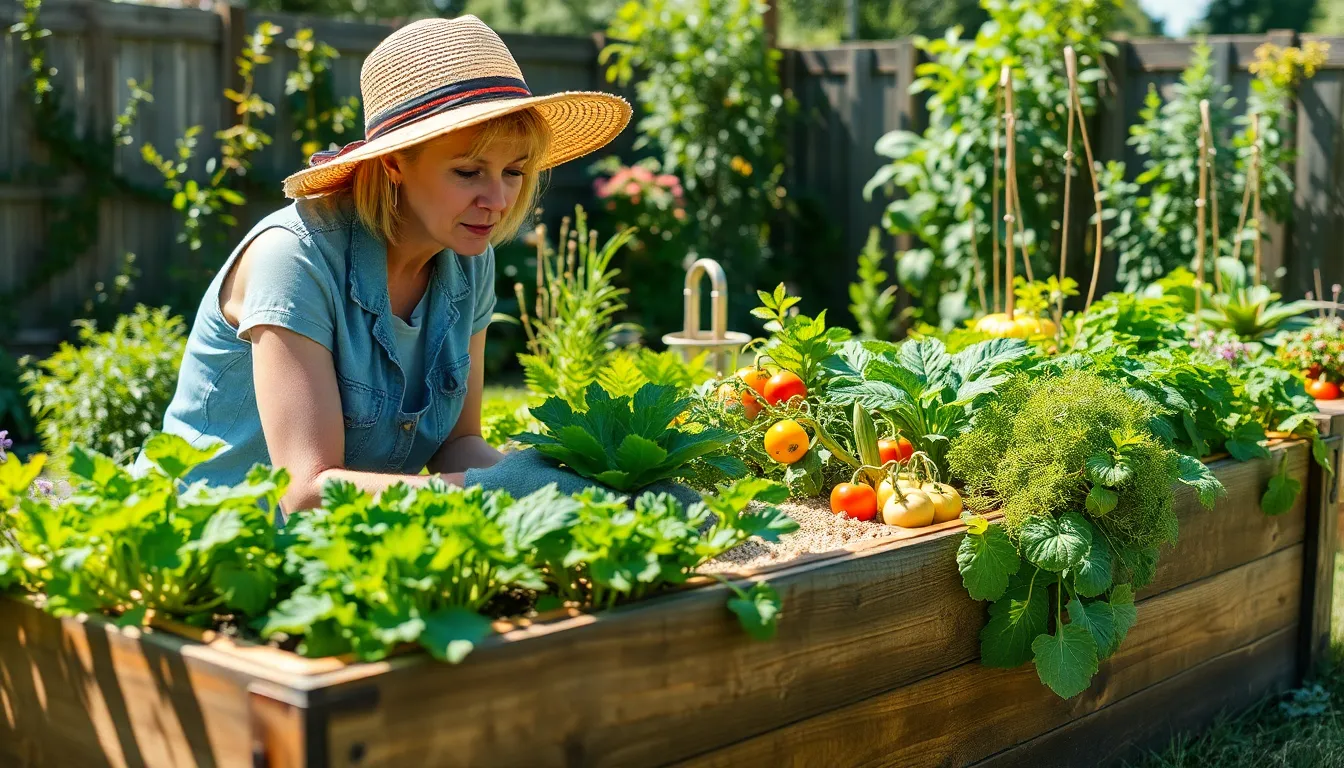
Building raised garden beds transforms challenging outdoor spaces into productive growing areas that we can easily maintain. These elevated structures give us complete control over soil conditions while reducing the physical demands of traditional ground-level gardening.
Select the Right Materials and Size
Materials make all the difference when we’re constructing durable raised beds that’ll last for years. Wood offers natural aesthetics and affordability, while composite materials provide superior longevity without regular maintenance needs. Recycled plastic frames deliver excellent weather resistance and eco-friendly benefits that many gardeners appreciate.
Size considerations directly impact both accessibility and productivity in our outdoor garden spaces. Standard dimensions between 4×4 to 4×8 feet allow us to reach all areas without stepping into the bed, preventing soil compaction issues. Width measurements shouldn’t exceed 4 feet since this distance enables comfortable access from both sides of the structure.
Improve Soil Drainage and Quality
Drainage systems prevent waterlogging that kills plant roots and creates anaerobic soil conditions. We should ensure our raised bed design includes adequate drainage holes or gaps at the bottom to allow excess water to escape naturally. Proper drainage becomes especially critical in areas with heavy clay soil or regions that receive substantial rainfall.
Soil quality improvements start with adding high-quality compost to enhance nutrient content and soil structure. Compost increases organic matter levels, improves water retention capacity, and creates better growing conditions for root development. We can blend compost with existing soil at a 1:1 ratio for optimal results in most garden situations.
Plan Optimal Plant Spacing
Plant density strategies in raised beds allow us to grow more vegetables in smaller spaces compared to traditional row gardening. Higher density planting helps shade out weeds naturally, leading to cleaner and more productive gardens that require less maintenance time. We can space plants closer together since the improved soil conditions support more intensive growing methods.
Vertical support systems maximize our growing space by training vining plants upward rather than outward. Trellises add visual appeal while supporting crops like tomatoes, beans, and cucumbers that would otherwise sprawl across valuable bed space. Strategic placement of these support structures ensures adequate sunlight reaches all plants throughout the growing season.
Design a Functional Vegetable Garden Layout
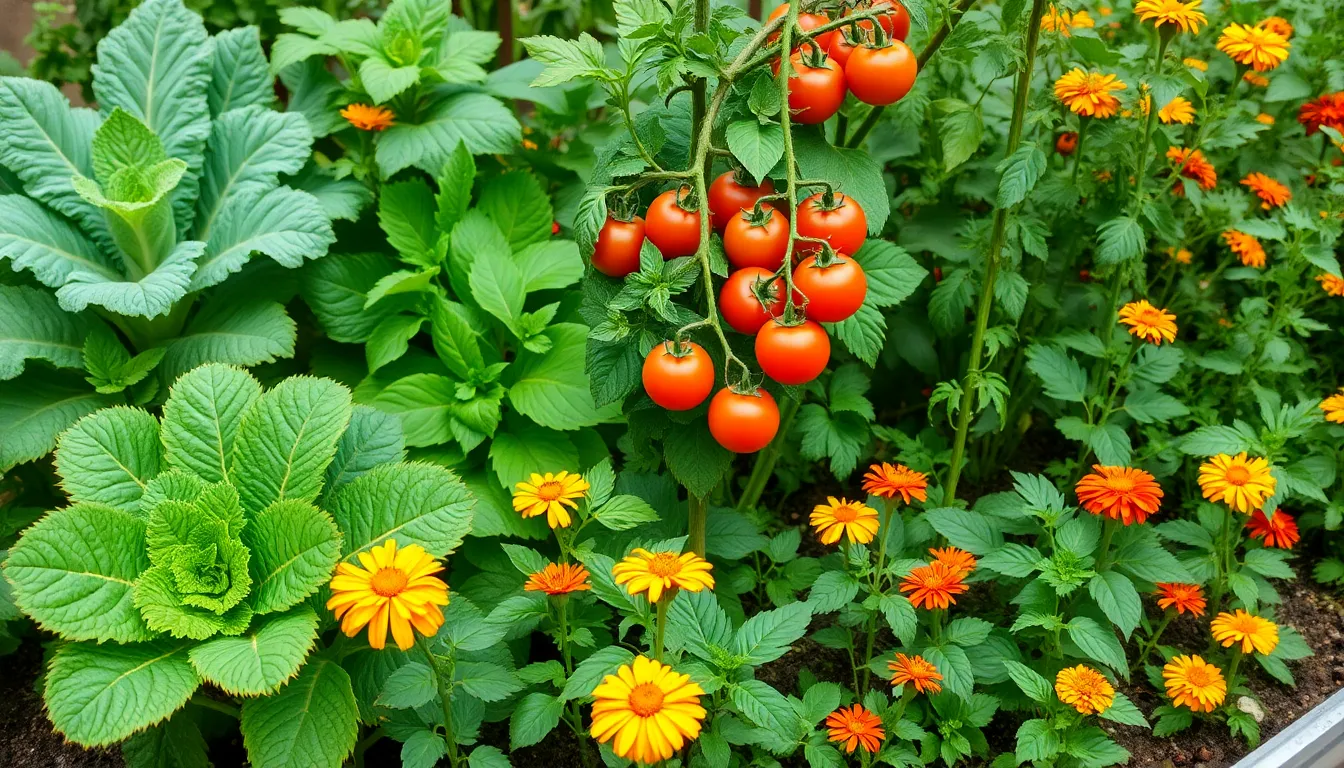
Building on our previous garden enhancements, we’ll now focus on creating a vegetable garden that maximizes productivity while working within your available space. Smart layout planning transforms even modest outdoor areas into thriving food production zones.
Choose High-Yield Crops for Small Spaces
Leafy greens dominate our recommendations for compact vegetable gardens because they produce continuous harvests throughout the growing season. Lettuce, spinach, and kale grow quickly in small spaces and can be harvested multiple times from the same plants. We can succession plant these crops every 1-2 weeks to maintain a steady supply of fresh greens.
Cherry tomatoes offer exceptional productivity in minimal space, often yielding 10-15 pounds of fruit per plant when properly supported. These compact varieties thrive in containers or small garden beds while producing abundantly throughout the summer months. We recommend determinate varieties for predictable harvests or indeterminate types for continuous production.
Herbs maximize flavor per square foot better than almost any other garden crops. Basil, oregano, thyme, and parsley grow prolifically in small containers or garden corners. Fresh herbs provide important cost savings compared to store-bought alternatives while offering superior flavor intensity.
Bush beans produce impressive yields in compact form, delivering 1-2 pounds of beans per plant over several weeks. These space-efficient legumes also improve soil nitrogen levels naturally, benefiting neighboring plants in our garden layout.
Carry out Companion Planting Strategies
Marigolds with tomatoes create one of our most effective pest deterrent combinations, as marigolds naturally repel nematodes that damage tomato root systems. Plant marigolds in a border around tomato beds or intersperse them between tomato plants for maximum protection.
Basil with tomatoes enhances both flavor and pest resistance when we grow these plants together. Basil improves tomato taste while repelling aphids, hornworms, and other common tomato pests. Position basil plants at the base of tomato supports for easy maintenance.
Beans with corn demonstrates classic companion planting principles where beans provide nitrogen fixation to support corn growth. Climbing beans use corn stalks as natural supports, maximizing vertical growing space. We plant beans around corn bases once corn reaches 6 inches in height.
Carrots with chives optimize root zone usage as carrots grow deep while chives remain shallow-rooted. Chives deter carrot flies and other root pests while their upright growth doesn’t compete with carrot foliage for sunlight.
Create Succession Planting Schedules
Cool season crops require systematic timing to maintain continuous harvests from spring through fall. We plant lettuce and spinach every 1-2 weeks during cool weather periods, ensuring fresh greens availability before older plantings bolt or decline. Start new plantings when previous ones reach half maturity.
Warm season crops benefit from staggered planting schedules that extend harvest windows beyond single large harvests. Plant tomatoes and peppers every 2-3 weeks during appropriate planting windows to spread production throughout the growing season. This strategy prevents overwhelming harvests while maintaining steady yields.
Quick growing radishes fill gaps between slower-maturing crops effectively, with harvest-ready roots in just 25-30 days. We interplant radishes between rows of carrots or lettuce to maximize space utilization while radishes mature and clear space for main crops to expand.
Bean succession extends fresh bean harvests for months rather than weeks by planting new rows every 2 weeks through midsummer. This approach ensures tender young beans throughout the growing season rather than having all plants mature simultaneously.
Establish a Relaxing Herb Garden Space
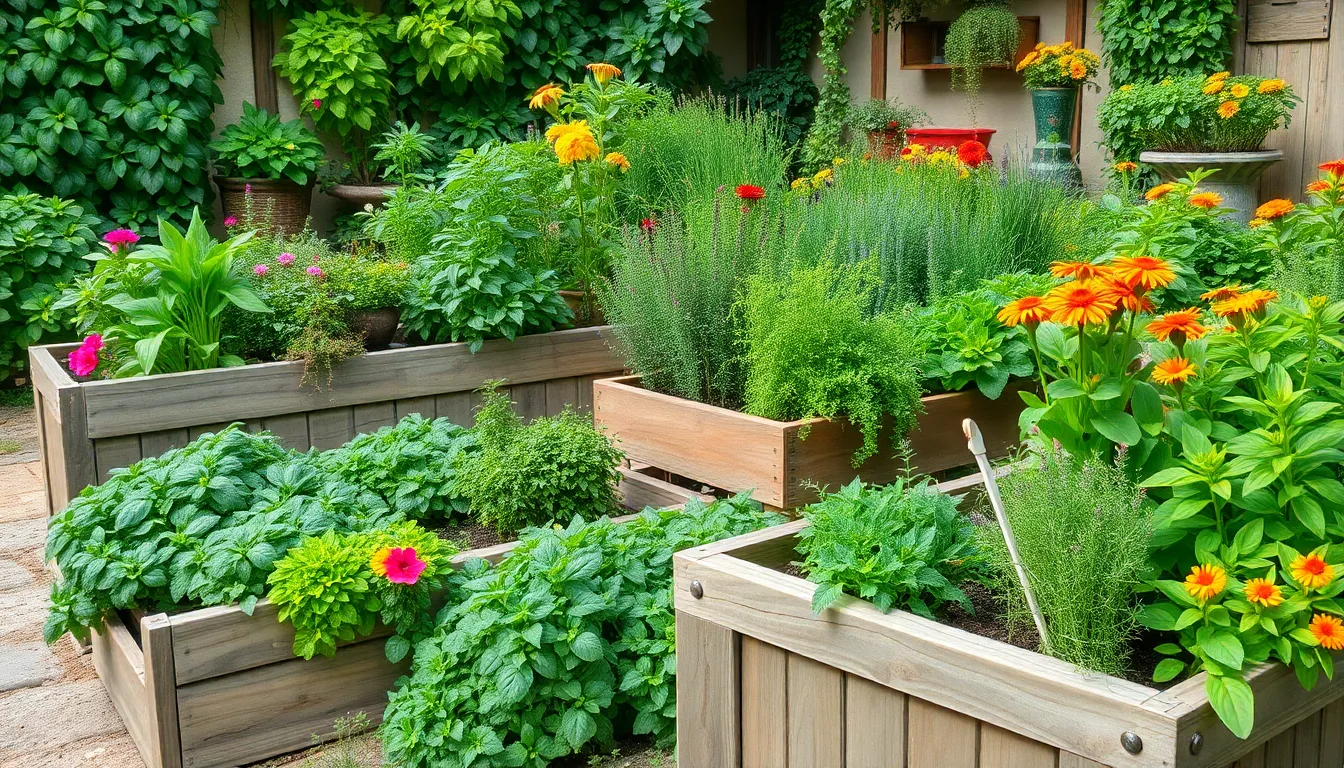
We can transform any outdoor space into a tranquil herb sanctuary that serves both practical and therapeutic purposes. Creating this peaceful retreat involves thoughtful planning of layout elements like raised beds, containers, and vertical gardens to maximize both space efficiency and visual appeal.
Select Culinary and Medicinal Herbs
Culinary herbs form the foundation of any practical herb garden, offering fresh flavors for our daily cooking needs. Basil stands out as the quintessential choice for pesto creation and caprese salads, while chives provide that perfect onion flavor boost to countless dishes. Sage becomes essential for stuffing and roasted meat preparations, and thyme offers incredible versatility across soups and sauces.
Medicinal herbs add therapeutic value to our garden sanctuary, supporting our wellness goals naturally. Calendula brings powerful anti-inflammatory properties that we can harness for skin care applications. Echinacea serves as our immunity booster during challenging seasons, while ginger provides reliable digestive support for stomach issues.
| Herb Category | Primary Uses | Key Benefits |
|---|---|---|
| Culinary | Cooking, seasoning | Fresh flavors, cost savings |
| Medicinal | Wellness, remedies | Natural healing, health support |
Design Themed Herb Garden Areas
Mediterranean themes create stunning focal points using oregano, rosemary, and thyme combinations that transport us to coastal regions. These drought-tolerant herbs thrive together while providing authentic flavors for Mediterranean cuisine preparations.
Herbal tea gardens offer daily relaxation opportunities through strategic placement of peppermint and chamomile varieties. We can design these spaces near seating areas where the soothing scents enhance our peaceful moments.
Sensory gardens engage multiple senses by mixing herbs with contrasting textures and distinctive fragrances. Lavender provides calming aromatherapy benefits while rosemary offers both visual appeal and robust scent profiles that create memorable garden experiences.
Plan for Proper Harvesting and Storage
Regular pruning encourages bushy growth patterns while preventing premature flowering that reduces herb potency. We should harvest herbs during morning hours when essential oils reach peak concentration levels.
Proper storage techniques preserve flavor and medicinal properties throughout the year using airtight containers or freezing methods. Fresh herbs maintain optimal potency when we store them immediately after harvesting, ensuring maximum benefit from our garden investments.
Strategic timing becomes crucial for maintaining continuous herb supplies, so we can plan successive plantings that extend our harvest seasons well into fall months.
Install Water Features for Tranquil Ambiance
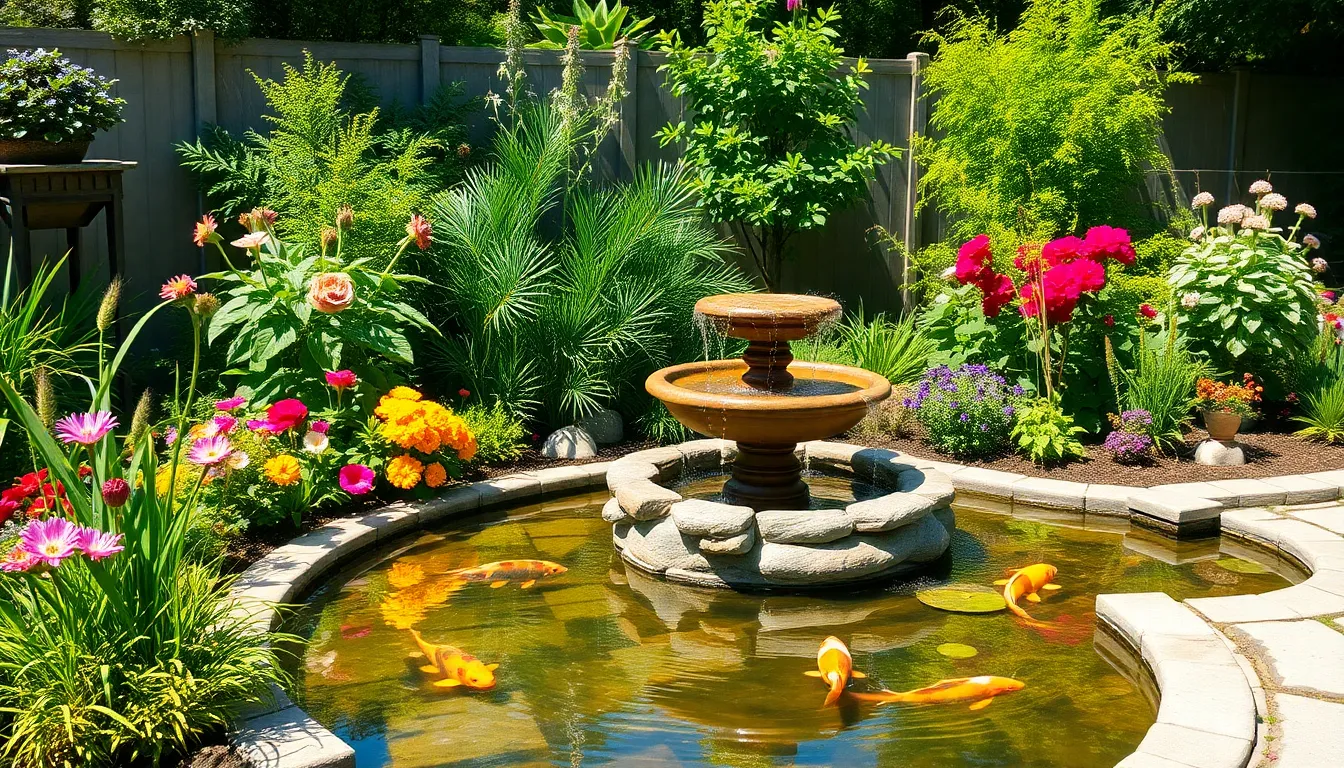
Water elements transform outdoor spaces into peaceful retreats that soothe the senses. We’ll explore three effective approaches to incorporate these calming features into your garden design.
Add a Simple Garden Fountain
Garden fountains offer the easiest entry point for introducing water into your outdoor space. These compact features require minimal installation while delivering maximum relaxation benefits through their gentle bubbling sounds.
DIY fountain projects let you customize size and style to match your existing industry design. We recommend starting with a basic tiered fountain kit that includes a pump, basin, and decorative elements. These beginner-friendly options typically cost between $50-200 and can be assembled in a weekend.
Pre-made fountain varieties provide instant gratification for busy gardeners who want professional results. Solar-powered models eliminate electrical concerns while reducing operating costs to zero. Battery operated units work perfectly in shaded areas where solar panels struggle to maintain consistent power.
Placement strategies determine your fountain’s impact on the overall garden atmosphere. Corner installations create intimate seating areas while central positioning makes the feature a focal point visible from multiple angles. We suggest testing different locations with a temporary setup before committing to permanent installation.
Create a Small Pond or Water Garden
Ponds establish vibrant aquatic ecosystems that support both plant and animal life. These substantial water features become living landscapes that evolve throughout the seasons.
Koi fish additions bring movement and personality to pond environments. Japanese koi varieties like Kohaku and Sanke create stunning visual displays with their bright orange, white, and black patterns. We recommend starting with 3-5 fish in a 500-gallon pond to maintain proper water chemistry balance.
Aquatic plant selections provide natural filtration while improving aesthetic appeal. Water lilies bloom from May through September, offering pink, white, and yellow flowers that float gracefully on the surface. Submerged plants like hornwort and anacharis oxygenate the water while preventing algae growth.
Decorative element integration transforms basic ponds into artistic masterpieces. Natural stone borders create seamless transitions between water and surrounding plantings. Underwater LED lighting systems extend viewing pleasure into evening hours while highlighting fish movements and plant textures.
Design Rain Gardens for Sustainability
Rain gardens capture stormwater runoff while creating environmentally responsible industry features. These shallow depressions filter pollutants naturally while reducing flooding risks in your neighborhood.
Native plant combinations thrive in rain garden conditions without requiring supplemental irrigation. Purple coneflower, black-eyed Susan, and wild bergamot establish deep root systems that improve soil drainage capacity. These perennials bloom from June through October, providing continuous color displays.
Infiltration benefits extend beyond your property boundaries to support community water management goals. A typical 300-square-foot rain garden processes runoff from a 1,000-square-foot roof area during heavy storms. We’ve observed 30-50% reductions in yard flooding after installing properly sized rain gardens.
Design considerations ensure rain gardens function effectively while maintaining visual appeal. Positioning these features 10 feet away from building foundations prevents water damage while maximizing runoff collection. Gentle slopes of 1-3% direct water flow naturally without creating erosion problems during intense rainfall events.
Incorporate Hardscaping Elements for Structure
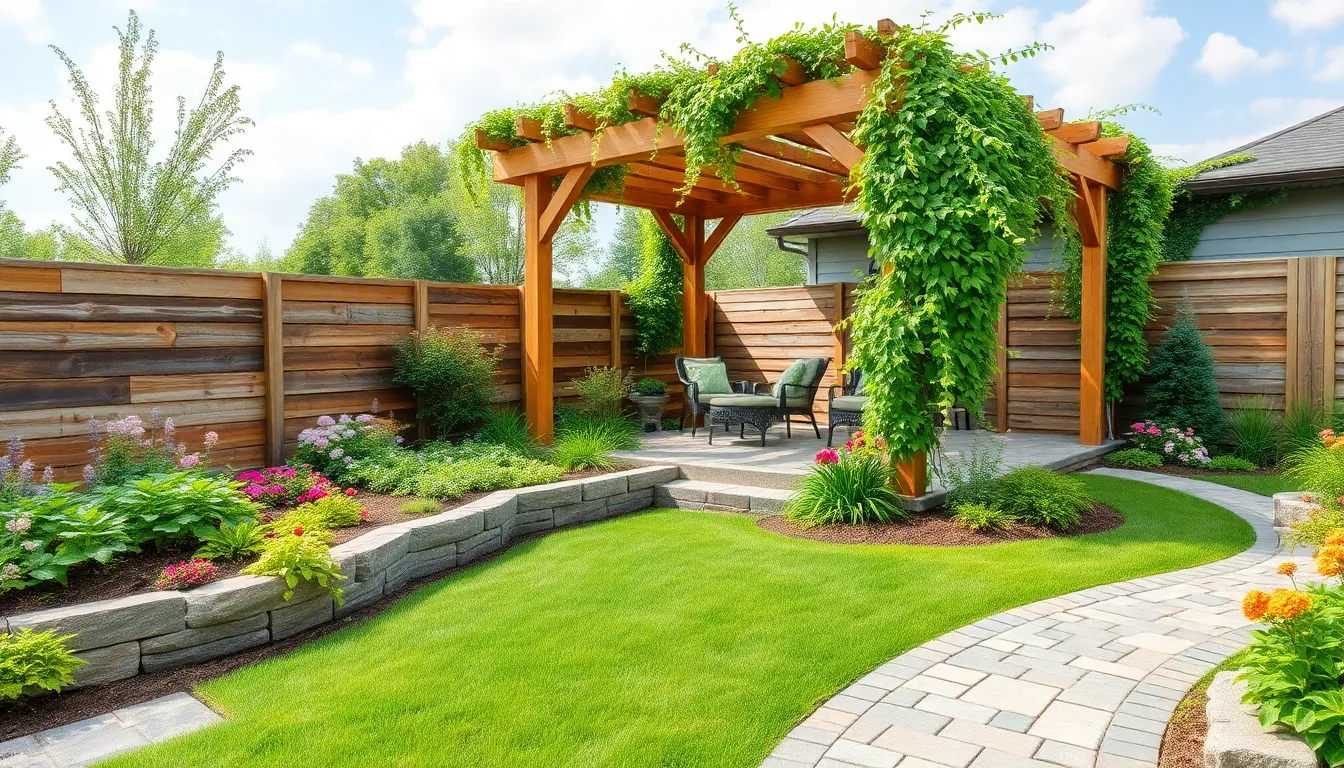
Hardscaping transforms our outdoor garden spaces by adding permanent structural elements that complement our plantings. These features create visual anchor points and define different areas within our garden design.
Build Attractive Garden Pathways
Paver stones offer endless design possibilities when we lay them in creative patterns throughout our garden spaces. We can arrange rectangular pavers in herringbone or basket weave configurations to add visual interest while creating durable walkways that withstand heavy foot traffic.
Gravel pathways provide a cost effective solution that delivers rustic charm to our outdoor garden areas. We’ll find that crushed granite or decomposed granite creates stable surfaces that drain well during rainy seasons while requiring minimal maintenance compared to other materials.
Brick pathways bring classic elegance to our garden design through their warm tones and traditional appeal. Bluestone alternatives offer sophisticated gray hues that complement modern industry styles while providing excellent durability for high traffic areas.
Add Retaining Walls and Borders
Stone retaining walls help us manage sloped terrain by creating flat planting areas that prevent soil erosion. We can stack natural fieldstone or cut limestone blocks to build walls that blend seamlessly with our existing industry while providing structural support for elevated garden beds.
Brick borders define our garden edges with clean lines that separate planting areas from lawn spaces. These durable materials resist weather damage while adding architectural detail that enhances our overall garden composition.
Timber retaining structures introduce natural textures that create rustic appeal in our outdoor spaces. We can use pressure treated lumber or cedar boards to construct raised borders that complement informal garden styles while providing practical soil containment.
Install Pergolas and Garden Arbors
Pergolas create stunning focal points when we position them over seating areas or along garden pathways. These vine covered structures provide partial shade during hot summer months while supporting climbing plants like clematis, grape vines, or jasmine that add fragrance and seasonal interest.
Garden arbors frame entryways and transitions between different garden rooms with vertical architectural elements. We can install these structures at gate openings or pathway intersections to create a sense of separation while adding height variation to our industry design.
Overhead structures extend our outdoor living spaces by defining areas for dining, relaxation, or entertainment activities. These features support string lights, hanging planters, or fabric panels that transform our gardens into functional outdoor rooms suitable for year round enjoyment.
Create Outdoor Living Spaces Within Your Garden
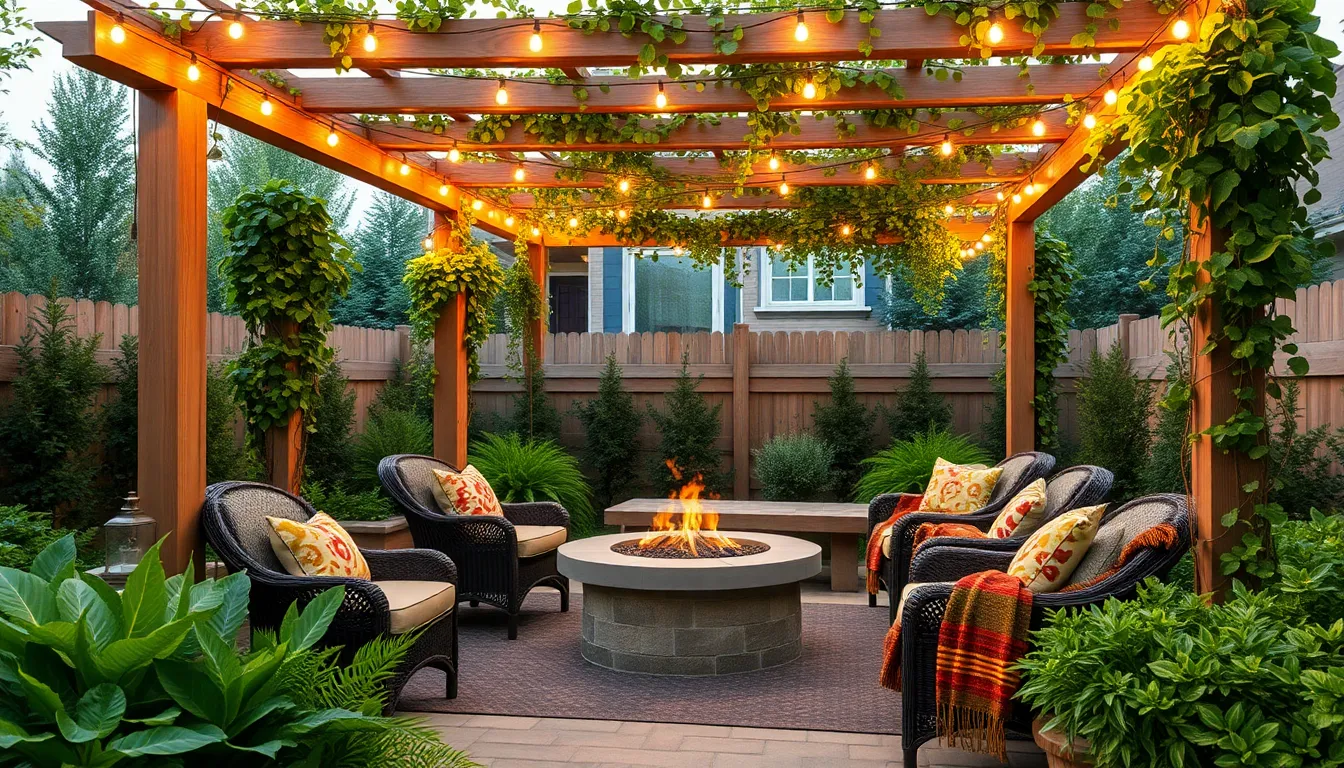
Building on the hardscaping foundation we’ve established, we can now focus on transforming our garden into functional living spaces that extend our home’s comfort outdoors.
Design Cozy Seating Areas
Weather resistant furniture forms the backbone of comfortable outdoor living spaces that withstand seasonal changes while maintaining their appeal. We recommend selecting pieces that complement our garden’s aesthetic, whether that’s rustic wooden benches for cottage gardens or sleek aluminum sets for modern landscapes.
String lights and lanterns create magical evening ambiance that transforms ordinary seating areas into enchanting gathering spots. Position these lighting elements at varying heights around seating zones to establish warm, inviting atmospheres that encourage longer outdoor stays.
Throw pillows and blankets add essential comfort elements during cooler evenings while introducing color and texture to our outdoor furniture. Choose weather resistant fabrics or store textiles in nearby containers to protect them from unexpected weather changes.
Build Fire Pits and Outdoor Kitchens
Fire pits serve as natural gathering spots that provide both warmth and captivating focal points for evening entertainment. We can choose from portable options for flexibility or permanent installations that become industry anchors, creating cozy spaces for conversation and relaxation.
Outdoor kitchens extend our culinary experiences into garden settings by incorporating grills and cooking stations that make al fresco dining effortless. These installations range from simple grill stations to elaborate outdoor kitchen complexes with prep areas, storage, and serving spaces.
Cooking stations strategically placed near dining areas maximize efficiency while keeping food preparation close to consumption zones. Consider incorporating counter space, storage answers, and easy access to water sources for comprehensive outdoor cooking capabilities.
Add Shade Structures and Privacy Screens
Pergolas create elegant shaded retreats while adding architectural interest that defines outdoor living spaces within larger garden areas. These structures support climbing plants like grapevines or flowering vines, creating natural canopies that evolve throughout growing seasons.
Privacy screens maintain intimate atmospheres without completely isolating outdoor living areas from surrounding garden beauty. We can choose from natural options like bamboo panels or living walls, or artificial materials that require minimal maintenance while providing consistent screening.
Umbrellas and canopies offer flexible shade answers that adapt to changing sun patterns and seasonal needs throughout the day. Position these portable options strategically around seating and dining areas to create comfortable microclimates that encourage extended outdoor use.
Plant Trees and Shrubs for Long-Term Beauty
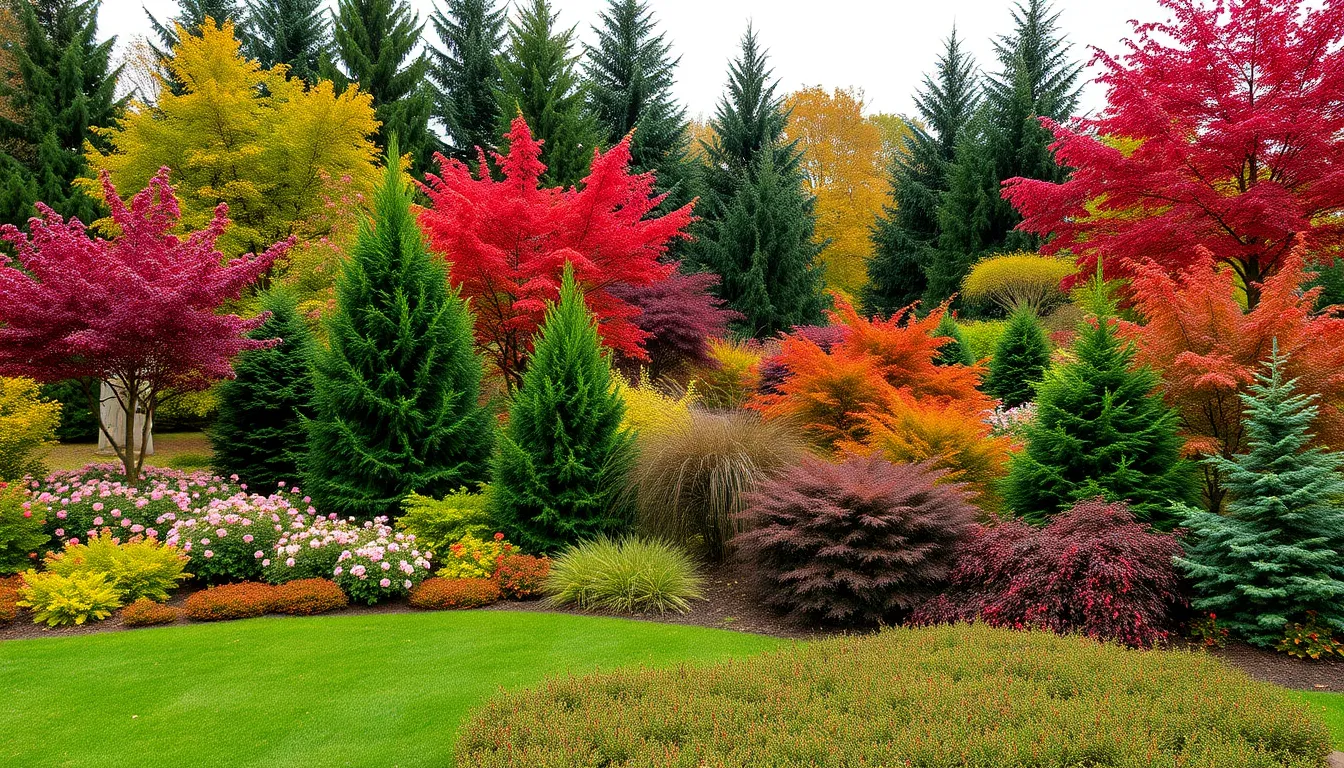
We establish the foundation of our outdoor garden through strategic tree and shrub placement. These structural elements provide year-round interest with foliage, flowers, and berries while creating lasting beauty that grows more valuable over time.
Choose Appropriate Sizes for Your Space
We select plants that match the scale of our garden to avoid overcrowding and maintenance issues. Compact shrubs and dwarf tree varieties work perfectly in smaller spaces, allowing us to enjoy the benefits of woody plants without overwhelming our industry. Oak trees and other large species thrive in expansive gardens where they have room to reach their full potential.
Dwarf varieties offer the same visual appeal as their full-sized counterparts while fitting comfortably in confined areas. We consider the mature size of plants when positioning them, ensuring adequate space for root systems and canopy spread. Strategic placement prevents future problems with foundation damage, power lines, or neighboring properties.
Scale relationships between plants create visual harmony throughout our garden design. We layer different sized plants from tall background trees to medium shrubs to low groundcover for depth and dimension. Proper sizing also ensures each plant receives adequate sunlight and air circulation for optimal health.
Select Plants for Multi-Season Interest
We choose species that offer something compelling throughout every season to maintain garden appeal year-round. Flowering perennials provide spring and summer color while evergreen shrubs and trees maintain structure and interest during winter months. This approach creates a ever-changing industry that evolves with the changing seasons.
Spring brings early blooms from ornamental trees like dogwood and cherry varieties that announce the growing season. Summer perennials fill gaps with continuous color while deciduous shrubs provide lush foliage and texture. Fall delivers spectacular foliage displays from maple trees and burning bush shrubs that create dramatic seasonal transitions.
Winter reveals the true backbone of our garden design through evergreen conifers and plants with interesting bark or berries. We incorporate holly bushes, winterberry shrubs, and pine trees that maintain visual interest when other plants go dormant. Berry producing plants also attract wildlife, adding movement and life to our winter garden.
Plan for Proper Pruning and Maintenance
We consider maintenance requirements when selecting trees and shrubs to ensure our garden remains manageable over time. Regular pruning maintains plant health and appearance while preventing overgrowth that can damage property or create safety hazards. Different species require exact pruning techniques and timing for optimal results.
Maintenance schedules vary significantly between plant types, with some requiring annual pruning while others need attention every few years. We research pruning requirements before planting to understand the long-term commitment each species demands. Proper timing prevents damage to plants and ensures healthy growth patterns.
Professional pruning may be necessary for large trees or specialized techniques, but many shrub maintenance tasks can be handled by homeowners with basic tools. We invest in quality pruning shears, loppers, and saws to maintain our plants properly. Regular maintenance prevents costly problems and keeps our garden looking professionally maintained throughout the seasons.
Design Specialty Garden Themes
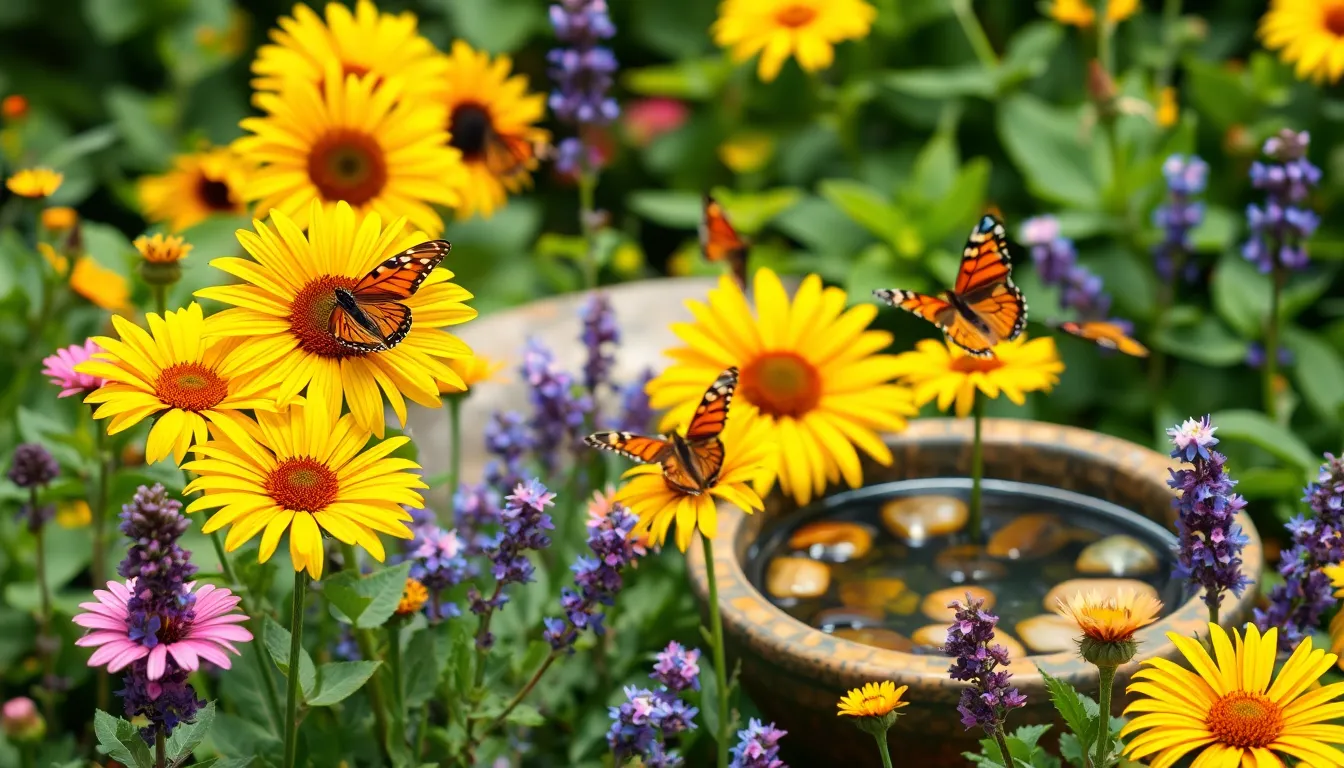
Specialty garden themes let us transform ordinary outdoor spaces into purposeful sanctuaries that serve exact functions while adding distinctive character to our landscapes.
Create a Butterfly and Pollinator Garden
Butterfly and pollinator gardens attract essential wildlife while creating vibrant displays of natural beauty throughout the growing season. We can establish these gardens by selecting nectar rich flowers like sunflowers, zinnias, and lavender that provide consistent food sources for butterflies and bees. These plants bloom at different times, ensuring continuous nectar availability from spring through fall.
Water features become crucial elements in pollinator gardens since butterflies need shallow drinking sources. We should add small dishes filled with water and pebbles, or create shallow puddles near flower beds where butterflies can safely land and drink. Sheltered roosting spots help butterflies survive windy conditions and overnight stays in our gardens.
Native plants work exceptionally well in these specialty gardens because local pollinators have evolved alongside them over centuries. We’ll find that native wildflowers require less maintenance while supporting larger populations of beneficial insects compared to exotic varieties.
Build a Rock Garden for Unique Textures
Rock gardens create stunning visual interest through contrasting textures while requiring minimal water and maintenance once established. We can design these gardens using various stone sizes and gravel types to build depth and architectural appeal throughout the industry. Large boulders serve as anchor points, while smaller rocks and pebbles fill spaces between drought tolerant plants.
Succulents and alpine plants thrive in rocky conditions because they’ve adapted to survive in harsh, well drained environments. These plants store water in their leaves and roots, making them perfect choices for areas where traditional flowers might struggle. Popular options include sedums, hen and chicks, and creeping phlox that spread naturally between stones.
Water features enhance rock gardens by adding sound and movement to otherwise static displays. We can install small fountains or birdbaths that complement the natural stone elements while providing wildlife with drinking opportunities. Solar powered features work particularly well since rock gardens typically receive full sun exposure.
Establish a Moon Garden for Evening Enjoyment
Moon gardens extend our outdoor living hours by featuring plants and elements specifically chosen for nighttime beauty and fragrance. We design these specialty spaces around night blooming flowers like jasmine and evening primrose that release their strongest scents after sunset. White and silver foliage plants reflect moonlight and artificial lighting, creating ethereal glows throughout the garden.
Lighting systems transform moon gardens into magical evening retreats through strategic placement of solar powered lights and string lights. We should position these fixtures to highlight key plants and pathways without overwhelming the subtle nighttime atmosphere. Soft, warm lighting works better than bright white lights for maintaining the garden’s peaceful ambiance.
Comfortable seating areas become essential components since moon gardens are designed for evening relaxation and contemplation. We can add weather resistant benches, chairs, or even hammocks positioned to take advantage of the most fragrant plants and attractive lighting displays.
Conclusion
We’ve explored countless ways to transform your outdoor space into a thriving garden sanctuary that reflects your personal style and meets your practical needs. From vibrant flower displays and productive vegetable plots to tranquil water features and specialty themed gardens each approach offers unique benefits for creating your dream industry.
The key to success lies in thoughtful planning that considers your space limitations budget and maintenance preferences. Whether you’re drawn to low-maintenance rock gardens pollinator-friendly butterfly habitats or functional outdoor living spaces the possibilities are truly endless.
Remember that great gardens evolve over time so don’t feel pressured to carry out everything at once. Start with one or two ideas that resonate most with your vision and gradually expand your outdoor oasis as your confidence and experience grow.
Your garden journey awaits and we’re confident these ideas will help you create an outdoor space that brings lasting joy and satisfaction for years to come.
Frequently Asked Questions
What’s the most important factor when planning a garden transformation?
Thoughtful planning is key to successful garden transformation. Consider your space limitations, budget, skill level, and personal style preferences. Choose plants and features that suit your local climate and maintenance capabilities. Strategic plant selection, particularly native species, ensures long-term success with minimal upkeep while supporting local ecosystems.
How can I create year-round color in my flower garden?
Focus on strategic plant selection with staggered bloom times. Plant native perennials in clusters for maximum visual impact, and map out bloom periods to ensure seamless color transitions. Incorporate foliage plants for structural continuity and add spring bulbs for early-season color. Layer plants by height for optimal visual appeal.
What are the key benefits of raised garden beds?
Raised beds transform challenging spaces into productive growing areas with easier maintenance. They provide better drainage, improved soil quality, and prevent soil compaction. Standard dimensions allow for higher density planting and better accessibility. They’re perfect for maximizing productivity in limited spaces while creating cleaner, more organized gardens.
Which vegetables provide the highest yield in small spaces?
Leafy greens, cherry tomatoes, herbs, and bush beans are excellent high-yield crops for compact areas. These plants provide continuous harvests throughout the growing season. Use companion planting strategies like pairing marigolds with tomatoes or beans with corn to enhance growth and naturally deter pests.
How do I design a functional herb garden?
Select a mix of culinary herbs (basil, chives, sage, thyme) and medicinal varieties (calendula, echinacea, ginger). Create themed areas like Mediterranean or herbal tea gardens for aesthetic appeal. Focus on proper spacing, adequate sunlight, and learn correct harvesting techniques to maintain herb potency and extend harvest seasons.
What’s the easiest way to add water features to my garden?
Start with simple garden fountains, which are easy to install and customize. Consider placement for optimal visual and auditory impact. Small ponds or water gardens create vibrant ecosystems with aquatic plants. Rain gardens are sustainable options that capture stormwater while adding visual interest through native plant selections.
How can hardscaping improve my garden design?
Hardscaping adds structure and functionality through pathways, retaining walls, and architectural elements. Use materials like paver stones, gravel, or brick for attractive walkways. Install pergolas and arbors for shade and plant support. These elements define spaces, manage terrain, and create year-round visual interest in your garden.
What makes trees and shrubs essential for long-term garden beauty?
Trees and shrubs provide year-round structure and increase property value over time. Choose plants with multi-season interest, including flowering varieties and evergreens. Select appropriate sizes to prevent overcrowding and ensure proper growth. Regular pruning and maintenance with quality tools keeps these investments healthy and beautiful for decades.
How can I create a garden that attracts wildlife?
Plant nectar-rich flowers for butterfly and pollinator gardens, and include water features for drinking and bathing. Choose native plants that support local ecosystems. Create diverse habitats with varying plant heights and bloom times. Avoid pesticides and provide shelter through dense shrubs or specialized wildlife structures.
What are some low-maintenance specialty garden themes?
Rock gardens require minimal maintenance while providing unique textures through drought-tolerant succulents and alpine plants. Moon gardens feature night-blooming flowers and strategic lighting for evening enjoyment. These specialty themes add distinctive character while serving specific functions and requiring less ongoing care than traditional flower gardens.

